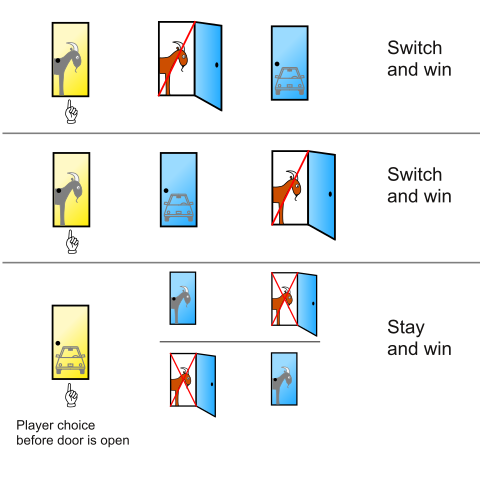
The Monty Hall Problem
The Monty Hall Problem has baffled mathematicians, statisticians and people alike, not because of its complexity, but due to its counterintuitive solution. The problem has sparked debates for decades, gaining widespread popularity after being discussed in a column by Marylin vos Savant in Parade magazine in 1990. The Monty Hall Problem challenges our instincts about probability and our rational reasoning behind it.
What’s The Problem?
The Monty Hall Problem comes from the gameshow Let’s Make a Deal and is named after the gameshow host, Monty Hall. During the show, contestants are presented with three doors: one with a hidden car prize and the other two concealing goats. They are then asked to pick the door they think the car is behind. Once chosen, Monty Hall, knowing which door contains the car, will open one of the other two remaining doors always containing a goat. The contestant is then given the choice to stick with their original choice or switch. Statistically, you will always have a higher chance of winning if you switch.
The Monty Hall Problem Explanation
The explanation to the Monty Hall Problem reveals why switching is better but may still not be easily accepted by our rational and logical selves. When a contestant makes their original choice, they have a 1/3 chance of picking the car and a 2/3 chance of choosing a goat. Once Monty then opens a remaining door to reveal a goat, the initial choice (which was 2/3 likely to be a goat at the time) will have better odds by switching to the other remaining door (which now has an increased 2/3 probability of being the car).
Psychological Aspects And Applications
The Monty Hall Problem reveals interesting insights into human decision making and cognitive biases that can lead to errors in our judgement. Many people incorrectly believe that once Monty reveals a goat, the probability of picking a car from the last two doors is 50/50 and don’t think that switching makes a difference to their chances.
Within educational settings, the problem helps inform us how strong our biases can be, even when presented with clear, contradictory facts, allowing students to hold discussions and debate their innate decision-making processes. Cognitive biases affect our everyday decision making, from personal relationships to challenges in work, where we often have to make decisions based on incomplete information. Re-assessing business negations based on new information, for example, could lead to better outcomes.
If you are interested in studying Maths or Psychology, Oxford Open Learning offer the chance to do so at several levels, listed below. You can also Contact Us.